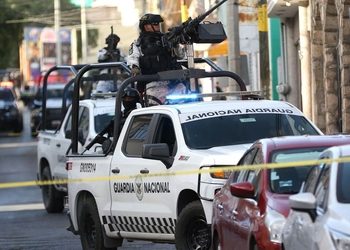As Mexico’s southern state of Tabasco deals with the fallout of a wave of violence, an unofficial policy is funneling vulnerable migrants there, providing organized crime groups with more criminal opportunities for profit.
The latest high-profile incident came on October 10, when an unnamed group of armed men published a video addressing the state’s governor, Javier May Rodríguez. The men accused the Tabasco Security Secretary Víctor Hugo Chávez Martínez of working with the Jalisco Cartel New Generation (Cartel Jalisco Nueva Generación – CJNG).
If May replaced “the filth” with someone neutral, then violence would stop, the men said. “Peace is in your hands,” they said.
The video followed a wave of violence that exploded in Tabasco’s state capital Villahermosa on October 3, just days after May took office following his victory in June’s general election. Local authorities reported an armed attack on local police in which two officers were injured, blockades appeared on major roadways, and multiple stores were set on fire.
Shifting Criminal Dynamics
Since February this year, when Chávez Martínez took over as security secretary for the state, homicides have doubled. In April, they were almost four times higher than during the most murderous months of 2023, according to data collected by the National Citizen Observatory (Observatorio Nacional Ciudadano – ONC).
Chávez Martínez’s predecessor, Hernán Bermúdez Requena, resigned in January following an explosion of violence linked to organized crime groups. A year prior, reports from Mexico’s Defense Ministry (Secretaría de la Defensa Nacional – Sedena) that were leaked by the Guacamaya hacker collective connected Bermúdez Requena and two other state police directors to the CJNG. At the time of his resignation, El Universal reported that the CJNG and other groups were fighting for control of Tabasco to carry out kidnappings, deal drugs, and extort migrants.
Some of the recent violence may also be related to the Barredora, a powerful criminal faction that fractured in December of last year, according to Chávez Martínez. A video allegedly published by the CJNG addressed the leaders of the Barredora, saying they would “clean” the state. Following the group’s breakdown, some cells of the Barredora have now aligned with the CJNG, according to the SSPC.
Migrants Caught in the Middle
In the midst of these changing criminal dynamics, migrants in Mexico, including those in Mexico City and further north, are being sent south to Tabasco’s capital by the Mexican Immigration Institute (Instituto Nacional de Migración – INM), moving migrants away from the country’s northern border with the United States.
The influx has offered organized crime groups further financial incentives to gain control of the state, as they can earn large sums from extorting vulnerable migrants. Some migrants have been moved south several times, offering criminal groups the chance to extort the same people many times over.
SEE ALSO:Vortex of Evil: Gangs and Narcos in Tapachula, Mexico
Up to 10,000 migrants have been bussed to Tabasco each month this year, according to official data obtained by Gretchen Kuhner, the director of Women in Migration Institute (El Instituto para las Mujeres en la Migración, AC – IMUMI) and published by The Washington Post in September. This is double the number that were being moved last year.
Tabasco’s shared border with Guatemala has long been a migrant hub in Mexico. In August, US Customs and Border Protection (CBP) extended access to its CBP One mobile application for non-Mexican citizens in Tabasco and Chiapas. That same month, INM announced it would provide buses toward the northern border for migrants once they were given a CBP One appointment.
Violence Spreads Throughout Southern Mexico
Violence has also engulfed nearby Chiapas, a state that shares a border with Tabasco and Guatemala and which is also a major point of entry into Mexico for migrants. There, criminal groups are also warring over control of the state and the migrant and drug trafficking routes that pass through it. Homicides have skyrocketed and Mexicans have been displaced into Guatemala due to fighting between criminal groups.
SEE ALSO:What Is Behind the Criminal Conflict Raging in Chiapas, Mexico?
Ernesto Lorda, director for North of Central America and Mexico at the Norwegian Refugee Council (NRC), told InSight Crime that 94% of the migrants the NRC interviewed in Mexico reported being victims of or witnessing violence in Mexico. “Most of that was robberies or extortion or threats,” Lorda explained.
The NRC has also noted an increase in human trafficking along Mexico’s border with Guatemala. “It’s not a coincidence that this is happening where there is a concentration of people on the move. It has become a business for them [organized crime groups],” Lorda said.
Increasing numbers of migrants arriving in southern Mexico only increases the risks they face from these groups.
Feature image: Mexico’s Guardia Nacional respond to violence in Tabasco. Source: Cuartoscuro.
Source link : http://www.bing.com/news/apiclick.aspx?ref=FexRss&aid=&tid=6712a8214a214402ad0a7fcda575c174&url=https%3A%2F%2Finsightcrime.org%2Fnews%2Fis-mexico-fueling-a-gang-war-by-sending-migrants-to-tabasco%2F&c=3773972390347663056&mkt=en-us
Author :
Publish date : 2024-10-18 07:23:00
Copyright for syndicated content belongs to the linked Source.
